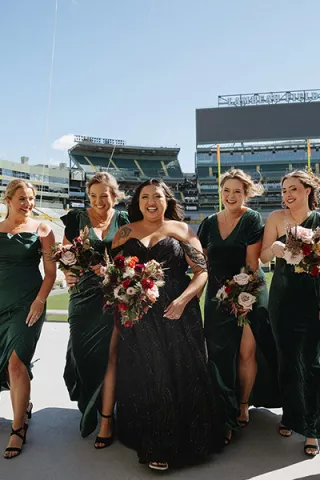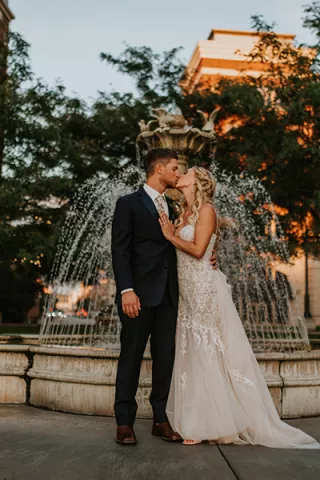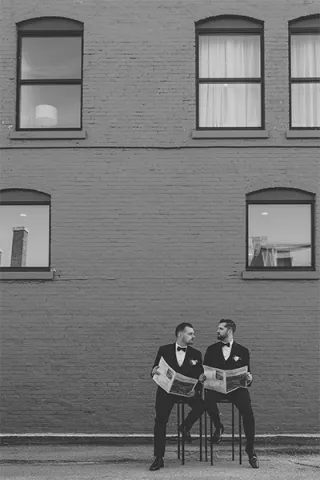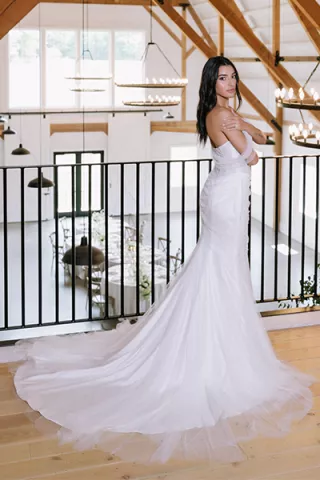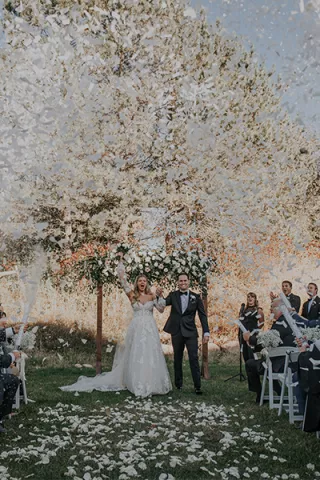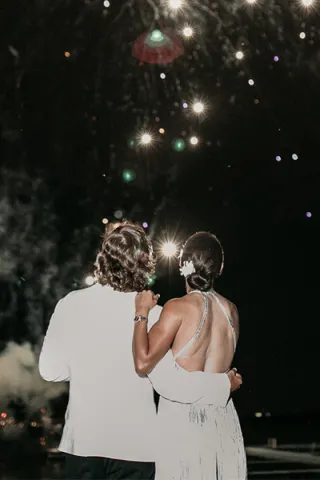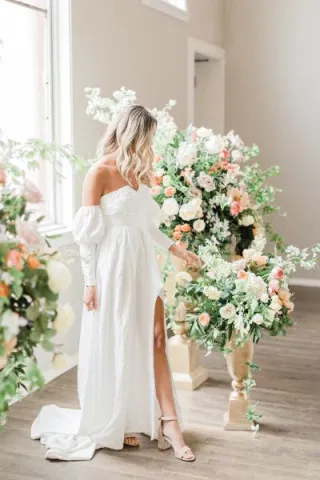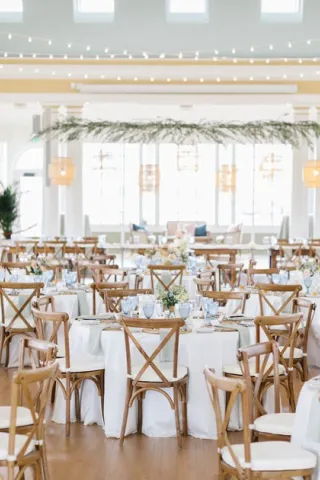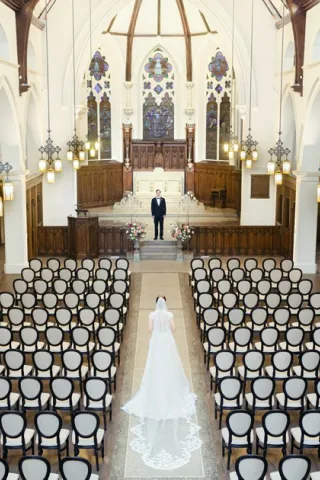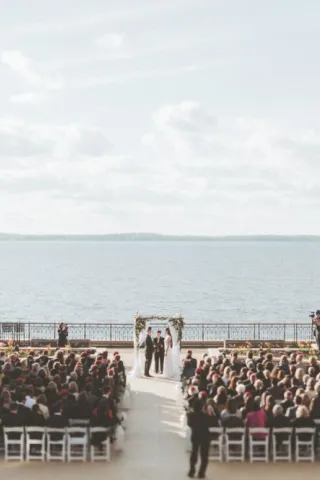Between the rousing sounds of lawn bowling and the tinkling of crystal, more and more brides and their grooms are exchanging “I dos” outdoors. Such was the scene when Mimi Johnson and Jim Rogers wed at Lake Park Bistro in June 2010.
The late-morning ceremony, in Milwaukee on the shores of Lake Michigan, was swathed in light reflecting off the water. “From day one we knew that we wanted to get married outside,” says Johnson, “It’s tough to beat the atmosphere of Wisconsin in the summer—especially along Lake Michigan or in Lake Country.”
Planning an outdoor wedding, especially in Wisconsin’s temperamental warm-weather months, is an exercise in patience and flexibility, with a little luck thrown in. But it’s one that reaps big rewards.
“Outdoor weddings can be stunning,” says bridal consultant Rachel Tatge of Top Shelf Weddings & Events in Madison, “but you must know what you’re getting yourself into.”
Working with weather for your outdoor wedding
For Johnson, the suspense leading up to her wedding day was both thrilling and exhausting. Tornadoes struck southeastern Wisconsin the week before the wedding. The night before, the big day had a chance of storms in the 10 to 80 percent range. Mother Nature delivered, sending rain and wind to the area, downing leaves and branches and making the “aisle” at Lake Park Bistro a bit mushy.
“You can study the Farmer’s Almanac and the weather history for the date, and you can check the forecast from the minute the 10-day [forecast] is available until the morning of,” says Johnson, who sported yellow pumps on her big day, but also brought yellow rain boots, just in case. “But there are no givens.”
Conni Hofeldt-Rowe, owner of Madison’s An Aire of Flair, says checking the Farmer’s Almanac for weather history is a good start, but a back-up plan is a necessity. In fact, she requires brides to have a back-up plan if they want to work with her.
“It’s important to make sure you have an alternative place that will accommodate your guests,” says Hofeldt-Rowe. “It’s peace of mind for you, and allows you and your guests to enjoy the day, whatever Mother Nature dishes up.”
Tatge agrees. “If it’s cold and rainy, it can put a huge damper on the event. An overcast day can be overcome, but it’s hard to work with pouring rain and blowing winds. A back-up plan is necessary, even if it’s just ordering sides for your tent to block wind and rain. My philosophy is to hope for the best and prepare for the worst. After all, we live in Wisconsin, and you never know what the weather will bring.”
 The back-up plan for Jane and Luke Kennedy’s bayside reception (pictured at left) at Sister Bay’s Marina Park on Green Bay included tents, but that was all the thought she put into it, despite her weather concerns.
The back-up plan for Jane and Luke Kennedy’s bayside reception (pictured at left) at Sister Bay’s Marina Park on Green Bay included tents, but that was all the thought she put into it, despite her weather concerns.
“I worried all year about the weather,” says Kennedy. “I was a total wreck. I wish I hadn’t worried so much.” Turns out Kennedy had nothing to fret about: Her wedding day weather was perfect, with gentle breezes off the water and a gorgeous, only-in-Door-
County sunset.
But even the best-laid plans can go askew. From the very start, says Johnson, the right attitude is important. “Because there are so many unknowns, you need to get in the right mindset from day one, and ensure you’re in that same mindset on the big day. I’m not sure how best to describe it, but it’s sort of ‘C’est la vie.’ ”
When planning an outdoor wedding, Hofeldt-Rowe advises that brides be forthright with their guests about day-of activities, so everyone can plan and dress accordingly. For instance, high heels might not be the best option for a reception in a grassy field.
Jennifer Bishop and her groom Jeff shared just enough information about their venue, the Enchanted Barn in Hillsdale, via their wedding website. “We had a link and pictures. Guests who took a look knew it would be more casual, that there was no need for high heels on the gravel.”
Outdoor wedding details
“You have no limitations when planning on outdoor wedding, nothing you have to abide by, so the possibilities are endless,” says Meghan Magritz, owner of Milwaukee’s City Bride. But it does take more preparation.
“One of the biggest surprises for brides is that it’s not as easy to plan an outdoor wedding as they think,” says Magritz. “It’s more than throwing up a tent and renting chairs. There are many other things to think about.” At a hotel, banquet hall or other indoor facility, on-site staff often take care of everything from flatware to ensuring the bathrooms have toilet paper. When planning an outdoor wedding, those duties fall to the bride or her planner and assistants.
“You have to think of tiny things that you might take for granted [or might not be an issue] in a traditional banquet setting: bathroom locations, bug spray and sunscreen availability for guests, the presence of bugs and animals, catering and clean-up staff, proximity to working electrical outlets for lights, catering and music,” says Tatge.
In fact, Hofeldt-Rowe says brides often don’t realize how many items need to be rented. Then there’s making sure that the day goes off without a hitch without the help of facility staff.
Tatge recalls one wedding during which a group of hungry chipmunks jumped on the guest tables, running off with the wedding favors (mini wrapped cakes). Even worse, some of the critters also decided to relieve themselves on the linens.
“That was not fun, but my assistant and I were prepared and cleaned up the mess and replaced the favors before the guests took their seats,” Tatge says.
With the additional rentals, outdoor weddings typically come at an added cost; Magritz estimates they can cost up to 20 percent more than an indoor wedding, depending on the number of guests. One cost that can easily be cut from the budget of an outdoor wedding, however, is décor.
Jennifer Foss and her husband Kyle were married at her father’s home in Burlington in southeastern Wisconsin, on eight acres of rolling countryside. The couple walked from the house to a pergola near a hill for their ceremony, then returned to the house for a poolside reception.
“We made a natural altar out there, and having it outside felt really authentic,” says Foss. “I’ve been to people’s weddings where they struggled with what flowers to put in a centerpiece and other super-specific details to figure out how to create a beautiful environment in a white-box space. With an outdoor wedding, the authenticity of the space is often all the beauty you need.”
“If you have a great venue,” says Bishop, who was married in a rustic barn, “it takes care of itself. Too much else and it’s distracting.”
 Freedom of wedding vendor choice
Freedom of wedding vendor choice
Despite the potential added costs, an outdoor wedding comes with freedom from prescribed vendors, set menus and hotel-standard ivory linens: “The day is completely yours,” says Hofeldt-Rowe.
After a lunch at the Bistro, guests rode busses to Johnson’s childhood home on Oconomowoc’s Lac La Belle for an evening of dancing, drinking and feasting.
In the company of many first-time visitors to Wisconsin, Johnson and her husband served up Wisconsin goodies such as a Culver’s frozen custard sundae bar and a cheese table. Foss, who now lives in California (where she met her husband through the local University of Wisconsin alumni group), took a similar approach. With guests hailing from both coasts, she offered her guests mac-and-cheese bites, miniature brats and beer shooters.
After the church ceremony in Baileys Harbor, Kennedy and her husband arrived by boat at their Marina Park reception. Johnson and her husband sailed off by illuminated boat from her parents’ house after their reception.
“The beauty of an outdoor wedding is that you throw so much to chance,” says Johnson. “You rely on the beauty of your surroundings and less on the man-made decorations. [But] while you leave a lot to chance, you also get the opportunity to really take liberties and mold everything into your own.”
“An outdoor wedding is already a bit untraditional, so embrace a different way of doing things. Figure out the experience you want to have with your guests, and then find a venue that matches that,” says Magritz. “It’s an opportunity to start with a clean slate.”
(Read more about Mimi Johnson and Jim Rogers' wedding here.)
Outdoor Weddings Considerations
- Restrooms Are there enough on-site? If not, bring in portable luxury restrooms that mimic traditional men’s and ladies’ rooms when hooked up to a water source and generator.
- Parking What’s available? Is it convenient? Jennifer Earl Foss hired a neighbor to park cars and Mimi Johnson bussed guests from one city to another. “Parking can be a big issue for outdoor weddings,” notes planner Meghan Magritz of City Bride.
- Permits Be sure to check with the local municipality about permits; they may be required for things such as music and serving alcoholic beverages. Also check for restrictions. Parks, for instance, often are only open during certain hours.
- Trash Dumpsters and extra trash containers are a must; the rental company can suggest how many will be needed based on your guest list and type of party. Be sure to check on recycling regulations as well.
- Prep and staging areas Is there a place for the bridal party to get ready? What kind of space is available for the caterer to do any on-site assembly? Ask vendors if they need special accommodations.
- Insurance “Wedding insurance can be a great idea for all weddings, because it’s so affordable and covers so many situations that could occur,” says Angela Dupont, owner of Top Shelf Weddings & Events in Madison. “The odds that something will go wrong when you have the myriad factors of an outdoor eve–nt are higher, making the likelihood of needing the insurance that much more.” She recommends wedsafe.com.
- Be a good neighbor If you’re having a home wedding, be courteous and give your neighbors a heads-up. “It’s just a nice thing to do,” says Magritz.
Get more from Wisconsin Bride! Follow us on Twitter and Facebook.
